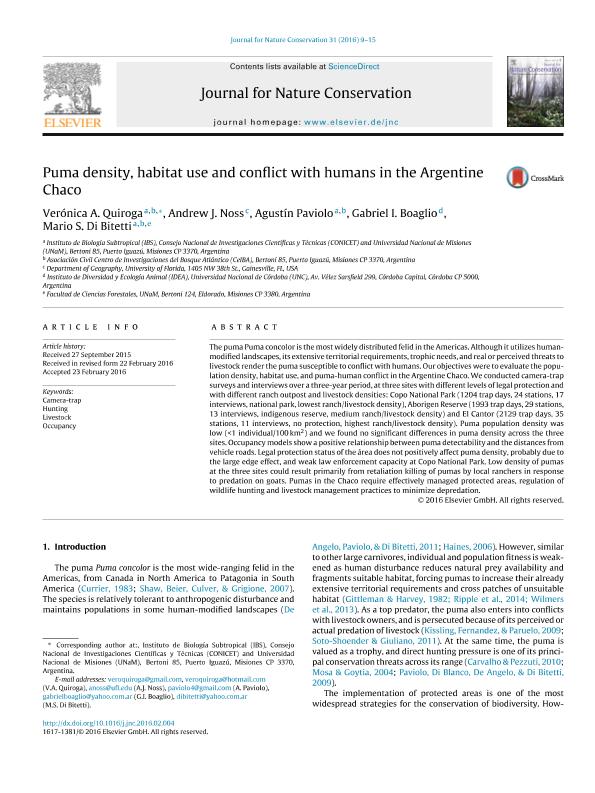Mostrar el registro sencillo del ítem
dc.contributor.author
Quiroga, Verónica Andrea

dc.contributor.author
Noss, Andrew

dc.contributor.author
Paviolo, Agustin Javier

dc.contributor.author
Boaglio, Gabriel Ivan

dc.contributor.author
Di Bitetti, Mario Santiago

dc.date.available
2018-05-15T21:32:51Z
dc.date.issued
2016-02
dc.identifier.citation
Quiroga, Verónica Andrea; Noss, Andrew; Paviolo, Agustin Javier; Boaglio, Gabriel Ivan; Di Bitetti, Mario Santiago; Puma density, habitat use and conflict with humans in the Argentine Chaco; Elsevier Gmbh; Journal For Nature Conservation; 31; 2-2016; 9-15
dc.identifier.issn
1617-1381
dc.identifier.uri
http://hdl.handle.net/11336/45294
dc.description.abstract
The puma Puma concolor is the most widely distributed felid in the Americas. Although it utilizes human-modified landscapes, its extensive territorial requirements, trophic needs, and real or perceived threats tolivestock render the puma susceptible to conflict with humans. Our objectives were to evaluate the popu-lation density, habitat use, and puma-human conflict in the Argentine Chaco. We conducted camera-trapsurveys and interviews over a three-year period, at three sites with different levels of legal protection andwith different ranch outpost and livestock densities: Copo National Park (1204 trap days, 24 stations, 17 interviews, national park, lowest ranch/livestock density), Aborigen Reserve (1993 trap days, 29 stations,13 interviews, indigenous reserve, medium ranch/livestock density) and El Cantor (2129 trap days, 35stations, 11 interviews, no protection, highest ranch/livestock density). Puma population density waslow (<1 individual/100 km2) and we found no significant differences in puma density across the threesites. Occupancy models show a positive relationship between puma detectability and the distances fromvehicle roads. Legal protection status of the área does not positively affect puma density, probably due tothe large edge effect, and weak law enforcement capacity at Copo National Park. Low density of pumasat the three sites could result primarily from retaliation killing of pumas by local ranchers in responseto predation on goats. Pumas in the Chaco require effectively managed protected areas, regulation ofwildlife hunting and livestock management practices to minimize depredation.
dc.format
application/pdf
dc.language.iso
eng
dc.publisher
Elsevier Gmbh

dc.rights
info:eu-repo/semantics/openAccess
dc.rights.uri
https://creativecommons.org/licenses/by-nc-sa/2.5/ar/
dc.subject
Camera-Trap
dc.subject
Hunting
dc.subject
Livestock
dc.subject
Occupancy
dc.subject.classification
Otras Ciencias Biológicas

dc.subject.classification
Ciencias Biológicas

dc.subject.classification
CIENCIAS NATURALES Y EXACTAS

dc.title
Puma density, habitat use and conflict with humans in the Argentine Chaco
dc.type
info:eu-repo/semantics/article
dc.type
info:ar-repo/semantics/artículo
dc.type
info:eu-repo/semantics/publishedVersion
dc.date.updated
2018-05-04T20:17:28Z
dc.identifier.eissn
1618-1093
dc.journal.volume
31
dc.journal.pagination
9-15
dc.journal.pais
Alemania

dc.journal.ciudad
Berlín
dc.description.fil
Fil: Quiroga, Verónica Andrea. Consejo Nacional de Investigaciones Científicas y Técnicas. Centro Científico Tecnológico Conicet - Nordeste. Instituto de Biología Subtropical. Instituto de Biología Subtropical - Nodo Puerto Iguazú | Universidad Nacional de Misiones. Instituto de Biología Subtropical. Instituto de Biología Subtropical - Nodo Puerto Iguazú; Argentina
dc.description.fil
Fil: Noss, Andrew. University of Florida; Estados Unidos
dc.description.fil
Fil: Paviolo, Agustin Javier. Consejo Nacional de Investigaciones Científicas y Técnicas. Centro Científico Tecnológico Conicet - Nordeste. Instituto de Biología Subtropical. Instituto de Biología Subtropical - Nodo Puerto Iguazú | Universidad Nacional de Misiones. Instituto de Biología Subtropical. Instituto de Biología Subtropical - Nodo Puerto Iguazú; Argentina
dc.description.fil
Fil: Boaglio, Gabriel Ivan. Consejo Nacional de Investigaciones Científicas y Técnicas. Centro Científico Tecnológico Conicet - Córdoba. Instituto de Diversidad y Ecología Animal. Universidad Nacional de Córdoba. Facultad de Ciencias Exactas Físicas y Naturales. Instituto de Diversidad y Ecología Animal; Argentina
dc.description.fil
Fil: Di Bitetti, Mario Santiago. Consejo Nacional de Investigaciones Científicas y Técnicas. Centro Científico Tecnológico Conicet - Córdoba. Instituto de Diversidad y Ecología Animal. Universidad Nacional de Córdoba. Facultad de Ciencias Exactas Físicas y Naturales. Instituto de Diversidad y Ecología Animal; Argentina
dc.journal.title
Journal For Nature Conservation

dc.relation.alternativeid
info:eu-repo/semantics/altIdentifier/doi/http://dx.doi.org/10.1016/j.jnc.2016.02.004
dc.relation.alternativeid
info:eu-repo/semantics/altIdentifier/url/https://www.sciencedirect.com/science/article/pii/S1617138116300115
Archivos asociados
